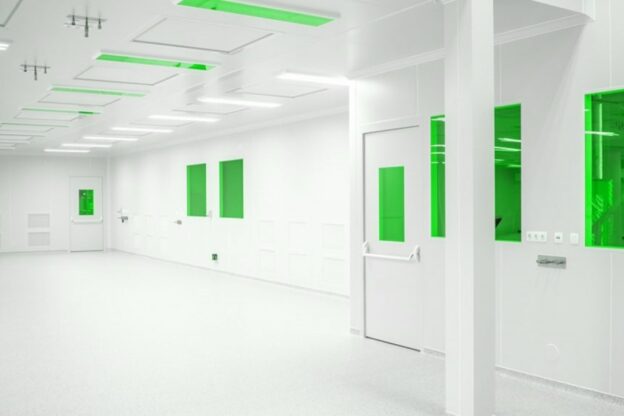Clean rooms are controlled environments essential for various industries like pharmaceuticals, electronics, biotechnology, and aerospace. Whether a facility is creating sensitive electronics or developing medical treatments, clean rooms are vital for minimizing contamination and ensuring product quality. But designing an efficient and compliant clean room requires more than just keeping contaminants out. Here are the foundational elements every facility needs to achieve compliance and optimize performance.
1. Establishing Clean Room Classification Levels
Clean rooms are classified according to the level of particulate matter permissible in the air, as outlined in standards like ISO 14644-1. Each class, from ISO 1 (the cleanest) to ISO 9, dictates the allowable concentration of particles per cubic meter. Understanding the clean room classification required for your specific processes is crucial. This classification affects everything from airflow rates to filtration requirements, guiding the design of each aspect of the room to meet specific regulatory needs.
2. Implementing Effective Air Filtration and Ventilation Systems
One of the primary functions of a clean room is to filter airborne particles. High-Efficiency Particulate Air (HEPA) and Ultra-Low Penetration Air (ULPA) filters are standard in clean rooms to capture particles as small as 0.3 microns. In many clean rooms, filtered air is directed in a unidirectional flow to carry contaminants away and prevent particle buildup. Regularly maintaining and monitoring these filters is essential for keeping particle counts within the required limits, ensuring both compliance and operational efficiency.
3. Maintaining Positive Pressure Levels
Clean rooms use positive pressure to prevent contaminants from entering. By maintaining a higher air pressure inside the clean room compared to adjacent areas, clean air flows out through any openings, rather than allowing contaminated air to flow in. This pressure differential is critical for compliance, especially in pharmaceutical and biotechnology settings where even minor contamination can compromise safety. Ensuring proper calibration of these pressure systems is essential to maintaining a clean, controlled environment.
4. Controlling Temperature and Humidity
Temperature and humidity levels impact both product quality and the comfort of personnel working within the clean room. In industries like pharmaceuticals, high humidity levels can lead to condensation, affecting chemical reactions and product stability. Clean rooms must be equipped with climate control systems that can maintain specific temperature and humidity levels. Monitoring these levels and ensuring they remain within the acceptable range is essential for compliance and maintaining a stable environment.
5. Choosing Non-porous, Easy-to-Clean Materials
The surfaces in a clean room should be non-porous, resistant to chemicals, and easy to clean. Standard materials include stainless steel, epoxy, and vinyl because they don’t shed particles, are corrosion-resistant, and are easy to sanitize. Every element, from floors to ceilings, should be designed with contamination control in mind. Clean room furniture, workstations, and equipment should also meet these criteria, ensuring that they do not contribute to particulate buildup and are easy to sterilize.
6. Ensuring Personnel Protocol and Gowning Procedures
People are one of the main sources of contamination in clean rooms. Implementing strict gowning procedures is necessary to control particles and microbial contaminants brought in by personnel. Many facilities use airlocks, or anterooms, where personnel are required to wear specific attire like gloves, gowns, masks, and boot covers. The design of the gowning area should facilitate smooth transitions, with designated areas for donning and doffing attire. Automated air showers can further reduce contamination risks, ensuring a cleaner transition into the main clean room area.
7. Integrating Continuous Monitoring Systems
Effective clean room design incorporates continuous monitoring systems to track environmental variables like particle count, temperature, humidity, and pressure. Automated sensors alert operators when levels drift outside acceptable ranges, enabling quick corrective action. By integrating monitoring into clean room design, facilities can uphold compliance and optimize efficiency without the need for frequent manual checks. Regular calibration of these monitoring systems is also essential for accuracy.
8. Establishing Proper Workflow and Zoning
Designing a clean room with an efficient workflow reduces cross-contamination and ensures compliance. Clean rooms are often divided into zones, from less controlled (where initial processing might occur) to more stringent areas for sensitive tasks. Maintaining separate workflows for raw materials, work-in-progress, and finished goods helps prevent contamination and ensures that sensitive operations are protected from exposure. Facilities should also minimize the movement of personnel and materials between zones to further maintain cleanliness.
9. Prioritizing Easy Maintenance and Cleaning Access
To keep a clean room operational and compliant, it must be easy to maintain and clean. Clean room designers should prioritize layouts that allow cleaning personnel to access every corner and surface without difficulty. Rounded edges, seamless surfaces, and limited furniture and equipment make it easier to sanitize the space quickly and thoroughly. Clean rooms also require maintenance routines to ensure HVAC systems, filters, and monitoring equipment remain in top condition, all essential for compliance and reliability.
Conclusion
Building a compliant and efficient clean room starts with understanding the basics of clean room classification, air filtration, pressure, and other critical elements. By integrating these foundational aspects into clean room design, facilities can create environments that protect product quality, safeguard personnel, and maintain regulatory compliance. An optimized clean room is not only an investment in meeting standards but also a commitment to operational excellence, helping facilities perform efficiently and consistently.
